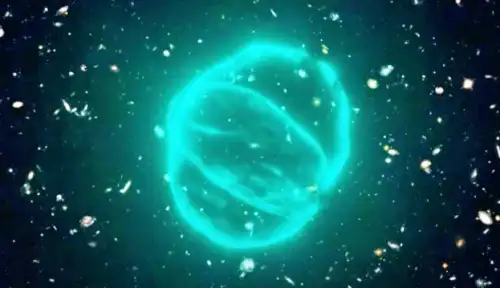Cosmic Mysteries. The Universe is far more than the familiar tapestry of stars, planets, and galaxies we observe through our ever-improving telescopes.
It is a vast, bewildering realm teeming with bizarre phenomena that continue to baffle even the most seasoned astronomers. Despite monumental technological leaps, scientists are perpetually confronted with cosmic riddles for which no clear, universally accepted explanations exist.
These anomalies challenge the very foundations of existing theories, defying the known laws of physics. They are both terrifying and intoxicating, inspiring a relentless quest for new knowledge that promises to reshape our understanding of reality itself.
Cosmic Mysteries, Enigma of Fast Radio Bursts (FRBs).
One of the most persistent and powerful puzzles in modern astrophysics is the phenomenon of Fast Radio Bursts (FRBs). These are incredibly potent, transient radio signals lasting mere milliseconds, yet they can unleash as much energy as the Sun generates over an entire day.
First detected in 2007, FRBs have since been observed repeatedly, with some sources exhibiting a recurring pattern. This repetition suggests that the phenomenon is not a one-off catastrophic event but rather a sustained, albeit still unknown, cosmic process.
Proposed explanations run the gamut from the plausible to the profoundly speculative. Early theories included the merging of neutron stars or the explosive flares of highly magnetized neutron stars called magnetars.
More exotic hypotheses have even hinted at the possibility of signals from extraterrestrial civilizations, though this remains an extremely remote possibility.
The discovery in 2020 of an FRB originating from within our own Milky Way, traceable to a magnetar, provided the strongest evidence yet that at least some FRBs are linked to these compact stellar remnants.
However, the diverse nature of FRBs some repeating, others non-repeating suggests there may be multiple underlying mechanisms. The FRB mystery remains an active and vibrant field of research, with every new detection deepening the questions about these powerful, cosmological explosions.
Cosmic Mysteries, Great Attractor.
An Invisible Gravitational Titan.
Our own Milky Way galaxy is not sitting still; it is hurtling through space, along with thousands of its galactic neighbours, toward an invisible gravitational anomaly known as the Great Attractor.
Located roughly in the direction of the Hydra and Centaurus constellations, this colossal structure exerts a gravitational pull so immense that it causes our galaxy and others in the Laniakea Supercluster to move at speeds exceeding two million kilometres per hour (2×106 km/h).
The primary challenge in studying the Great Attractor is that it is obscured from optical view by the Zone of Avoidance a dense, intervening region of dust and gas in our own galactic plane.
Scientists hypothesize that the Attractor is an immense over-density of matter, perhaps a vast concentration of galaxy clusters or an unknown form of matter, possibly including Dark Matter, which makes up about 27% of the total mass-energy of the Universe.
However, the precise nature of the object remains elusive. Some models suggest the Attractor is not a single, dominant object but rather the central gravitational sink of a much larger, more massive structure called the Shapley Supercluster that lies even farther away.
The Great Attractor is thus a profound demonstration of the Universe’s large-scale structure and the enduring power of gravity, even when the source remains shrouded in mystery.
The Cold Spot.
A Cosmic Flaw in the Microwave Background.
The Cosmic Microwave Background (CMB) is the faint, uniform afterglow radiation from the Big Bang, a nearly perfect thermal snapshot of the early Universe.
Yet, when scientists analyzed the CMB, they discovered a significant anomaly: the CMB Cold Spot. This colossal region of the sky is noticeably cooler than the surrounding average temperature by approximately 70 microkelvins (70μK).
This temperature deviation is far larger than the fluctuations predicted by the standard cosmological model (ΛCDM, or Lambda Cold Dark Matter).
One leading hypothesis to explain the Cold Spot is the presence of a Supervoid an extremely large region of space with a significantly lower-than-average density of both ordinary and dark matter.
As light (photons) from the CMB passes through this massive gravitational “hole,” it loses energy due to the Integrated Sachs-Wolfe (ISW) effect, appearing cooler to us. However, initial studies suggested that the Supervoid in the direction of the Cold Spot (the Eridanus Supervoid) is not large or deep enough to fully account for the observed temperature drop.
This has led to far more provocative, though still speculative, alternative theories, including the possibility that the Cold Spot is a “bruise” or bubble left by a cosmic collision with another, separate universe in a broader multiverse.
Whether it is an extreme statistical fluke, a Supervoid, or a signal of new physics, the Cold Spot continues to challenge the basic assumptions of the standard cosmological model.
Odd Radio Circles (ORCs).
A New Class of Cosmic Objects.
In 2019, a new and profoundly strange class of astronomical object was detected using radio telescopes: Odd Radio Circles (ORCs). These structures appear as highly symmetric, nearly perfect rings in the radio spectrum but are completely invisible in optical, infrared, and X-ray wavelengths.
This unique characteristic makes them distinct from known cosmic phenomena like supernova remnants, planetary nebulae, or typical galaxies.
Only a handful of ORCs have been confirmed, but they share a common morphology: a bright, circular edge with a dark centre, often with an identifiable galaxy nestled within the circle. Current theories suggest ORCs could be spherical shockwaves from an incredibly colossal and short-lived event in a galaxy’s core, such as the merger of two supermassive black holes or a hyper-energetic burst of star formation.
Another compelling explanation suggests they are galactic winds or superwinds outflows of gas and plasma from a galaxy, possibly driven by numerous simultaneous supernovae, that propagate outward and create a radio-bright shell.
Their sheer size, often hundreds of thousands of light-years across, points to cataclysmic events on a cosmic scale. The sheer novelty and unexplained nature of ORCs strongly suggest that they represent a completely new class of astrophysical object, awaiting definitive classification.
The Amaterasu Particle.
An Ultra-High-Energy Enigma.
Physics was fundamentally challenged in 2021 with the detection of a single ultra-high-energy cosmic ray with a staggering energy exceeding 240 exa-electronvolts (2.4×1020 eV).
This particle, named Amaterasu after the Japanese Sun Goddess, is the second-most energetic cosmic ray ever recorded, surpassed only by the famed “Oh-My-God” particle of 1991. Its energy is tens of millions of times greater than the particles created by the largest human-made accelerators, like the Large Hadron Collider.
What makes Amaterasu so perplexing is its apparent point of origin. When traced back through the heavens, the particle appears to have originated from a region of space known as the Local Void, an immense, empty expanse where there are virtually no stars, galaxies, or other known high-energy sources.
According to prevailing high-energy astrophysics, the particle should have lost significant energy through interaction with the Cosmic Microwave Background (a process known as the GZK limit) if it had traveled from a distant, powerful source.
The fact that it arrived with such immense energy and from an “empty” region throws existing models of cosmic ray acceleration and propagation into question.
The particle’s existence suggests two equally revolutionary possibilities: either there are unknown astronomical objects capable of accelerating particles to unimaginable energies lurking in the void, or our fundamental understanding of particle physics and how magnetic fields deflect cosmic rays is incomplete, possibly requiring a paradigm shift beyond the Standard Model.
The Unending Frontier.
The five anomalies described here Fast Radio Bursts, the Great Attractor, the CMB Cold Spot, Odd Radio Circles, and the Amaterasu Particle are just a few examples of the profound and humbling mysteries presented by the Universe. They are compelling indicators that our current theoretical frameworks, while remarkably successful, are incomplete.
These cosmic conundrums push scientists to develop new observation techniques, propose alternative physical laws, and expand the boundaries of known theories.
If you’d like a deeper dive into one of these mysteries, like the Cold Spot, this video provides more insight: Freezing Cosmos: The Cold Spot in the Cosmic Microwave Background.
The Universe is an inexhaustible well of the unexplained, and as long as these mysteries remain, the cosmos will continue to inspire and demand the search for knowledge.
Have a Great Day!





